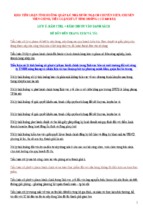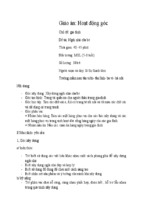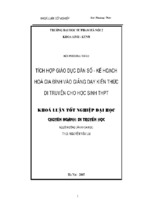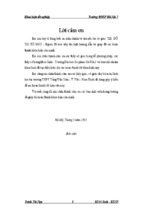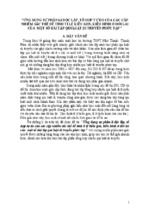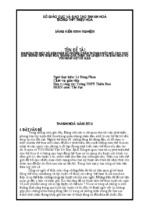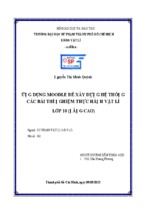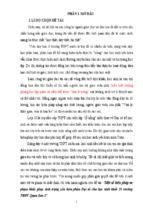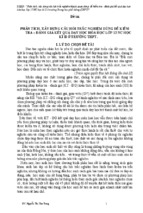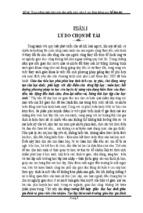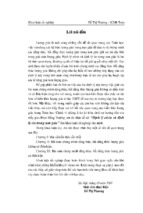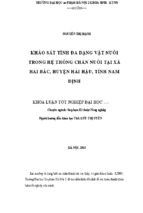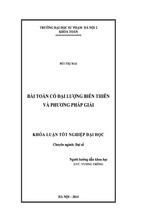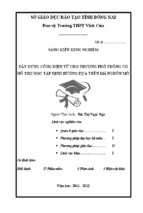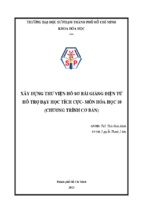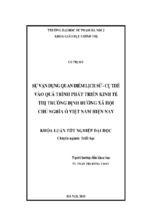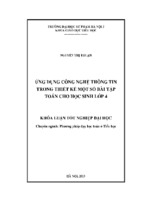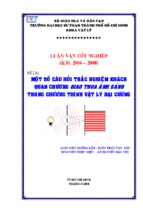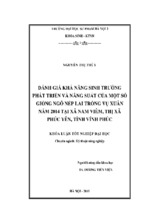SỞ GIÁO DỤC VÀ ĐÀO TẠO ĐỒNG NAI
Đơn vị TRƯỜNG THPT CHUYÊN LƯƠNG THẾ VINH
Mã số: ................................
SÁNG KIẾN KINH NGHIỆM
TEACHING STUDY SKILLS IN A HIGH
SCHOOL ENGLISH CLASS
(DẠY KĨ NĂNG HỌC TẬP TRONG LỚP HỌC TIẾNG ANH Ở TRƯỜNG
PHỔ THÔNG)
Người thực hiện: ĐINH THỊ PHƯƠNG THOA
Lĩnh vực nghiên cứu:
- Phương pháp dạy học bộ môn: TIẾNG ANH
Năm học: 2011 - 2012
2
SƠ LƯỢC LÝ LỊCH KHOA HỌC
I. THÔNG TIN CHUNG VỀ CÁ NHÂN
1. Họ và tên: ĐINH THỊ PHƯƠNG THOA
2. Ngày tháng năm sinh: 19 - 05 - 1983
3. Nam, nữ: Nữ
4. Địa chỉ: 54D/12, KP 2, Trảng Dài, Biên Hòa, Đồng Nai
5. Điện thoại:
(CQ)/
(NR); ĐTDĐ: 0938023960
6. Fax:
E-mail:
[email protected]
7. Chức vụ:
8. Đơn vị công tác: Trường THPT Chuyên Lương Thế Vinh
II. TRÌNH ĐỘ ĐÀO TẠO
- Học vị (hoặc trình độ chuyên môn, nghiệp vụ) cao nhất: Thạc sỹ
- Năm nhận bằng: 2011
- Chuyên ngành đào tạo: Lý luận và phương pháp giảng dạy tiếng Anh
III.KINH NGHIỆM KHOA HỌC
- Lĩnh vực chuyên môn có kinh nghiệm: 6
Số năm có kinh nghiệm: 6
- Các sáng kiến kinh nghiệm đã có trong 5 năm gần đây:
Influences of Communication Styles on Vietnamese Students’ English Speaking
Skill
Drama as a Technique for Teaching Speaking
3
CONTENTS
I. RATIONALE
II. IMPLEMENTATION
A. LITERATURE REVIEW
B. METHODOLOGY
Subjects
Research instruments
Procedures
1. Conducting a small survey
2. Holding a short study skills quiz
3. Finding out students’ learning styles
4. Teaching study skills in English lessons
4.1. General study skills
4.1.1. Time management
4.1.2. Memory improvement
4.1.3. Note-taking
4.2. Substantial study skills for learning English
4.2.1. Dictionary skill
4.2.2. Guessing meaning of words
4.2.3. Distinguishing content words and function words
4.2.4. Rhythm and intonation
4.2.5. Skimming and scanning
4.2.6. Building sentences
III. RESULTS
IV. IMPLICATIONS AND SUGGESTIONS FOR TEACHING
V. REFERENCES
TEACHING STUDY SKILLS IN A HIGH SCHOOL ENGLISH CLASS
I. RATIONALE
It is undeniable that Vietnamese high school students are overwhelmed with
their school work. Faced with poor student performance on tests and assignments,
teachers often recognise that the root of the problem lies not only in the material or
in how it is taught, but also in how students choose to study it. Some students lack
experience with effective methods of study; they measure the effectiveness of their
studying by the length of time they spend in front of a book - not in their
comprehension of it. Harsh reality sets in when grades are dispensed!
Study skills are some of the most important lessons that a teacher can give a
student and can have a positive effect on their performance in school. Having good
study skills is an invaluable asset in all areas of life, not just school. Though many
students may be proficient in basic math, reading and writing, they may not have
very strong functional skills in how to use and apply what they have learned. But
very often, teachers do not pay much attention to teaching them the necessary
study skills required in their particular subjects at school.
Therefore, students should be equipped with substantial study skills to reach
their full potential. In the scope of this paper, study skills are limited to the basic
ones in learning English.
II. IMPLEMENTATION
A. LITERATURE REVIEW
Study skills are defined as abilities, techniques, and strategies which are
used when reading, writing or listening for study purposes (Richard et al., 1992).
They are also described as approaches applied to learning (Wikipedia, 2011). They
are generally critical to success in school, are considered essential for acquiring
good grades, and are useful for learning throughout one's life.
Because of their importance in teaching and learning, they have received
considerable attention from researchers as well as laypersons. Visiting some
bookstores or with just some clicks on the Internet, we can find lots of information
on the topic. Below are some noticeable types of study skills:
Methods based on memorization such as rehearsal and rote learning
Methods based on communication skills e.g. reading and listening
Methods based on cues e.g. flashcard training
5
Methods based on condensing information, summarising and the use of
keywords
Methods based on visual imagery
Methods based on acronyms and mnemonics
Methods based on exam strategies
Methods based on time management, organization and lifestyle changes
Effective study skills include figuring out one’s learning style, learning time
management skills, studying in short bursts, blocking out distractions, not
cramming, revising, doing the hard stuff first, doing homework, taking good
notes, and so on.
As for study skills in English, a large numbers of books can be found in various
bookstores and libraries. It is easy to find such books if one looks at book covers
with the title “How to…” or “Preparation Course for…” Each book is appropriate
a certain purpose or a certain student, but in general, one must practise the
language regularly, manage his/her time wisely, and train his/her memory.
B. METHODOLOGY
Subjects
The subjects of the study are students of class 10 English 2, Luong The Vinh
Specialised High School in the school year 2011-2012. Generally speaking, all the
30 students are rather good at English. However, when it comes to how to study
effectively, not all of them have good answers.
Research instruments: survey, quiz, questionnaire, experimental
teaching, observation.
Procedures
1. Conducting a small survey
In the first English period of the school year (introduction or orientation
period), a small survey was conducted: Students were asked to work in groups of 5
to discuss their difficulties in learning English and how to overcome them. Totally,
there were 6 groups. The results showed that most students had difficulties in
managing time (83.3%), listening and speaking (83.3%), remembering vocabulary
and structures (66.7%), and writing (66.7%).
Realising the students’ lack of study skills, the author decided to bring some
study skills to her English lessons.
2. Holding a short study skills quiz
6
The author asked the students to complete a short quiz to find out if they have good
knowledge of study skills. Below are the quiz and the answers:
Check to see if you selected the correct answer.
What can you do to avoid stress?
Skip class
Sleep
Set goals and plan ahead
Don't take notes in class
When is the best time to study?
During the day
At night
After eating
Immediately after learning new material
What can you do if you don't like to sit and read for a long time?
Just don't read the books
Try taking breaks or studying in groups
Have friend read you the books out loud
Drink a lot of caffeine
How can I pay attention in class when it seems so boring sometimes?
Connect the material to other information
Bring your Ipod
Sit in the back and get some shuteye
Doodle in your notebook
How can I stop procrastinating?
Make a schedule and follow it
Watch all your TV shows until you're tired of watching TV
Just wait until the last minute because eventually you'll stop
Watch movies that have smart people in them
(Adopted from http://www.trustyguides.com/study-skills-quiz.html# )
Here are the results:
Number of correct answers Number of students Percentage
5
5
16.67
4
7
23.33
7
3
2
1
0
10
7
0
1
33.33
23.33
0
3.33
The results show that just a minority had all correct answers. The majority (73.3%)
knew how to study (they had at least 3 correct answers). But the problem lies in
how to put them into practice.
3. Finding out students’ learning styles
Identifying one’s learning style is the first step towards effective learning.
Knowing one’s own learning style can help him/her improve the excellence of
his/her study skills.
The following simple test was used to identify the students’ specific learning
styles.
Answer the following questions. If your answer is “yes” to most of the questions in
a section, your learning style can be the one in that section.
LEARNING STYLE
VERBAL
LOGISTICAL
QUESTIONS
Do you like playing on the sound of
words like tongue twisters or on the
meaning of words?
Do you always try to find out meaning
for new words?
Do you remember names, places and
dates well?
Do you wish to discuss about the topics
that you have learnt recently with our
friends?
Do you write well?
Do you get irritated when someone
makes grammatical errors?
Do you enjoy logic puzzles and
strategic games?
Do you like to memorize formulas?
Do you always look for rational
explanations?
Do you feel comfortable in analyzing,
measuring and quantifying?
YES NO
8
VISUAL
PHYSICAL
INTERPERSONAL
INTRAPERSONAL/
SOLITARY
Do you like to read charts and diagrams
rather than reading text?
Do you like to daydream a lot?
Do you like to draw pictures?
Do you have a great sense for colors?
Do you imagine how objects would
appear in various angles?
Do you enjoy doing puzzles and other
visual activities?
Do you enjoy outdoor activities?
Are you an expert in one or more sports
activities?
Do you like hand-on working?
Do you find it difficult to sit for long
periods?
Do you like to touch things, when
learning about them?
Do you like to practice everything,
rather than simple reading topics?
Do you like to learn in group?
Do you enjoy group activities and
games?
Do you prefer discussing about topics
with your friends?
Do you try to improve the skills of your
friends voluntarily?
Do you listen well and understand
other's views?
Do you like to spend quality time with
your instructor?
Do you have leadership skills?
Do you prefer working or studying
alone?
Are you private and independent?
Are you aware of your own thinking?
Do you have strong opinions about
various things?
Do you prefer working in a quiet
atmosphere?
Do you like to plan and set objectives?
9
The results show that the majority of them (27 out of 30 students) have a
mixed learning style – the combination of several learning styles. Only 3 of them
have the solitary learning style. This means most of them will benefit from a
variety of teaching and learning techniques:
Visual learning style: taking detailed notes from textbooks, creating pictures in
your mind.
Auditory style: saving information in audio tapes and listening to them; reading
the lessons aloud or discussing the information with classmates to gain better
understanding.
Verbal learning style: using audio tapes of lessons for repetition; making use of
some word based techniques like scripting or assertions; reading the key points in
the lessons aloud; connecting the words and forming a memorable sequence;
changing voice modulations to keep the content interesting while reading aloud.
Physical learning style: moving your hands or playing with the physical parts;
using hands-on work and movement in your learning process; using physical
objects, flash cards; writing and drawing pictures.
Logical style of learning: attempting to understand the reasons behind the
contents.
Solitary learning style: clarifying your doubts with an instructor, creating a
personal interest on your lessons.
Social style: sharing your views and scripts with others in your group and listening
to their comments.
4. Teaching study skills in English lessons
4.1. General study skills
4.1.1. Time management
Many students complain that they do not have sufficient time to complete
learning all their lessons. It is therefore worth knowing how to create a study
schedule and make use of the limited time effectually. The following task was used
in class to help students learn how to set priorities and control their time
effectively.
This task was added in the speaking period of Unit 1 – English 10, where
students talk about their timetable. It is advisable to remind them to be realistic in
creating the time schedule.
10
Task List: Work in pairs.
Use the following list to help you set your priorities for the up-coming week.
First, make a list of tasks that require time from your life.
Second, estimate the amount of time you need for each task.
Third, prioritize each task, using an A, B, C system.
A = necessary or urgent
B = important but not necessary or urgent
C = not necessary or urgent
Fourth, schedule these tasks on the weekly planner.
Priority
Estimated Time Needed
___Sleeping
___________________
___Eating
___________________
___Hygiene/Self Care
___________________
___Laundry/Cleaning
___________________
___Grocery Shopping/Cooking
___________________
___Exercise
___________________
___Extracurricular Clubs/Activities ___________________
___Spiritual/Religious Activities
___________________
___Seeing Friends & Socializing
___________________
___E-mail
___________________
___Talking on the Phone
___________________
___Watching TV
___________________
___Attending Classes
___________________
___Study Time Class #1
___________________
Reading __________
Research __________
Other: __________
Working Problems __________
Writing __________
Other: __________
___Studying Class 2
Reading __________
Research __________
Other: __________
___________________
Working Problems __________
Writing __________
Other: __________
___Studying Class 3 ___________________
Reading __________
Research __________
Other: __________
Working Problems __________
Writing __________
Other: __________
___Studying Class 4 ___________________
Reading __________
Research __________
Other: __________
___Other:
Working Problems __________
Writing __________
Other: __________
___________________
4.1.2. Memory improvement
Building a powerful memory is an essential part in learning everything, not
just English. In order to help the students to memorize better, the author put them
into groups to discuss ways to remember things. This was done as an extra activity
11
for the post-listening section of unit 2 where students talk about their problems at
schools.
When giving feedback, the teacher provided her students with other ideas for
building a good memory by delivering handouts (Adapted from Langan, 2002:
207, and from http://www.helpguide.org/life/improving_memory.htm ). They were
asked to read the handout more carefully at home and try to apply some
mnemonics to other lessons.
Handout:
How to develop your memory? – By:
1. Organizing the material to be learnt
2. Intending to remember
3. Testing yourself repeatedly
4. Using several memory techniques
5. Spacing memory work over several sections
6. Overlearning
7. Studying before sleep
Memory techniques:
Mnemonics: clues of any kind that help us remember something, usually by
helping us associate the information we want to remember with a visual image, a
sentence, or a word.
Mnemonic
device
Visual
image
Technique
Associate a visual image with a
word or name to help you
remember them better. Positive,
pleasant images that are vivid,
colorful, and three-dimensional
will be easier to remember.
Make up a sentence in which the
Acrostic (or first letter of each word is part of
sentence) or represents the initial of what
you want to remember.
Example
To remember the name Rosa Parks
and what she’s known for, picture
a woman sitting on a park bench
surrounded by roses, waiting as her
bus pulls up.
The sentence “Every good boy
does fine” to memorize the lines of
the treble clef, representing the
notes E, G, B, D, and F.
An acronym is a word that is made
The word “HOMES” to remember
up by taking the first letters of all
the names of the Great Lakes:
Acronym the key words or ideas you need to
Huron, Ontario, Michigan, Erie,
remember and creating a new word
and Superior.
out of them.
12
Mnemonic
device
Technique
Example
The rhyme “Thirty days hath
Rhymes, alliteration (a repeating
September, April, June, and
Rhymes and sound or syllable), and even jokes
November” to remember the
alliteration are a memorable way to remember
months of the year with only 30
more mundane facts and figures.
days in them.
Chunking breaks a long list of
numbers or other types of
Chunking
information into smaller, more
manageable chunks.
Remembering a 10-digit phone
number by breaking it down into
three sets of numbers: 555-8675309 (as opposed to5558675309).
Imagine placing the items you
want to remember along a route
Method of
you know well or in specific
loci
locations in a familiar room or
building.
For a shopping list, imagine
bananas in the entryway to your
home, a puddle of milk in the
middle of the sofa, eggs going up
the stairs, and bread on your bed.
4.1.3. Note-taking
Taking good notes on the material that is taught while in school will help
students later when doing assignments in class, homework, and at test time. This
can be taught in listening periods when students have to listen for specific details
to answer comprehension questions. Before letting students listen to the
recordings, the teacher can remind them quickly how to take notes:
Do not write everything down. Only write down the important
information: names of important persons, dates, geographic locations,
formulas, steps to solve problems, etc.
Write in short hand. Write short words or phrases, not complete
sentences.
Write in an organized manner. Use a new line for each point and make an
outline by using numbers and letters.
The teacher can also remind them how to take notes in general:
Use a notebook. Use a notebook of some kind when taking notes in class.
Use a different book for each class.
Review your work. After class review the notes that you took. At this
time you can add dates, people, and information you may have missed in
class. This will also give you a chance to add any additional words or
phrases to help you later.
13
Use your notes. Take out your notes when completing assignments,
homework, and when studying for tests. Some teachers will also allow you
to use notes when taking tests.
4.2. Substantial study skills for learning English
4.2.1. Dictionary skill
Using dictionaries is an essential study skill that anyone who wants to be
good at a language must have. However, not all of the students know how to make
the best use of their dictionaries.
This skill can be taught in several class periods – when students encounter
new words or phrases, or when they are not sure of the spelling, pronunciation or
usage of a word. They can also find collations, idioms and phrasal verbs.
Sometimes, dictionaries are good tutors of writing.
Dictionary skills are the most easily seen practicable when it comes to
looking up idioms. Students must know what and where to look it up. For example,
to look up the idiom “in black and white”, students must identify the key words in
the idiom – black and white, not in or and, and they must turn to the page with the
word black as fast as possible.
Besides, students should know what to learn from a dictionary. For instance,
they should realise the phrases in bold in certain example sentences. Those are
collocations – what word often goes with what. Moreover, some dictionaries also
provide learners with “writing tutor”, which can be used in writing lessons as a
valuable source of reference.
Below is an example of teaching students how to use their dictionaries:
14
4.2.2. Guessing meaning of words
Guessing meaning from context: If the word is used in a sentence, look at the
other words and see if they give you clues to the word's meaning. This may help to
guess, at least, part of the word's meaning.
This technique is very common in reading passages in the textbook. When students
do this kind of exercises, teachers can remind them that there are many ways to
help them guess the meaning of unfamiliar words from the context, and help them
focus on specific techniques for each task. For example, they can guess meaning
from:
Definition: The writer will use key words, or signal words to identify a
definition.
Key words: is/are, means/mean, is/are called, what this means is, is/are known as,
consist of, is/are defined as, refer to, is/are described as, may be seen as
Restatement: The writer may use other words, phrases, or sentences to
provide the meaning of difficult words
Key words: or, that is to say, in other words, i.e. or that is
Punctuation marks: The writer will write unfamiliar words and then use
punctuation, words, phrases, or sentences to explain the meaning of the new
words.
Key words: , commas, , , appositive, ( ) parentheses, - - dashes, ; semicolon, :
colon
Examples:
Key words: such as, like, for example, for instance, is / are
Contrast:
Key words: but, instead of, even though, in contrast to, yet, in spite of, although,
as opposed to, unlike, despite, however, on the other hand, whereas, fond of, still
provided that
Similarity
Key words: like, similarly, in the same way, as the same as, just as
Surrounding words
Pictures
15
Experience and background knowledge
Imagination
Guessing meaning from structure: understanding of morphology helps to break
down a word into smaller pieces (prefix, root, and suffix) so that you can guess
what it means.
For example: Let's use the word "predetermined" as our example.
Predetermined= pre + determine + ed
We may know that the base (root) word 'determine' means to decide; the
prefix 'pre' means before, and the suffix 'ed' is used to mean the past tense of a
verb. Therefore, "predetermined" would mean to have already decided the outcome
of something before it happened.
4.2.3. Distinguishing content words and function words
Content words are words that convey information in a text or a speech act.
Content words include nouns, main verbs, adverbs, adjectives, question words,
demonstratives, negatives and numbers.
Function words are words that express grammatical relationships.
Function words (adopted from Kelly, 2000: 74).
16
In a sentence, content words are usually stressed, and function words are
usually unstressed unless they are to be given special attention. This is
17
fundamental in speaking, listening as well as in reading. Knowing this will help
students in their listening (listen to the content words first), speaking (where to put
the stress in a sentence) better. And in reading, it helps with skimming (direct their
eyesight to the content words first).
This skill should be taught in the first listening periods as most students have
difficulty in listening. They tend to try their best to catch every word the speaker
says, resulting in the fact that they do not understand the main ideas. Besides, it is
worth teaching them the strong and weak forms in speaking and in listening.
4.2.4. Rhythm and intonation
Rhythm: English is a stressed-time language, which means there is a tendency for
stressed syllables to occur at regular intervals.
The term intonation refers to the way the voice goes up and down in pitch when
we are speaking.
Rhythm and intonation are essential in speaking naturally. Teaching this
requires much time, but the teacher can choose to teach a specific common
intonation pattern in English in each lesson. This can be done in speaking lessons
when the teacher prepares students to speak.
Below are some common intonation patterns in English (O’Connor &
Fletcher, 1989).
Fall on complete, denote statement
18
Wh-questions
The voice often falls in questions beginning with ‘When, Where, Why,
What,’ etc.
Yes/No questions
The voice usually rises in questions to which the answer is ‘Yes’ or ‘No’.
Alternative questions
19
e.g.
The speaker mentions two possible answers. The voice rises on the first
alterative, and falls on the second. The two possible answers may be single words,
as above, or longer phrases:
e.g.
Question tags
falling
The speaker is certain of what he/she says. He/She expects the other person to
agree with him/her. The voice falls on the question tag.
e.g.
rising
The speaker is not certain. He/She is asking for confirmation. The voice rises on
the question tag.
e.g.
Echo questions
The speaker repeats something said by another person:
1. while he/she thinks what to reply
e.g.
20
2. to query what the other person said, ask for further explanation
e.g. A: Every cook should have a computer.
B:
A: Yes, to keep a record of menus and recipes.
3. because he/she did not hear or understand or believe what was said
e.g. A: The new manager is coming tomorrow. His name is Sprot.
B:
Correcting
1. The voice falls on the correct word, to emphasise it.
e.g. A: Her birthday is on the tenth of December.
2. The voice falls and rises on the incorrect information, then falls on the correct
information, to emphasise it.
Listing
The voice rises on each item of the list, until the final one, where it falls.
Polite rise
Because a rise sounds less definite than a fall, it can be used to sound polite,
especially when beginning a conversation. It is common when answering the
phone.
Yes/No short answers
The voice often falls on ‘Yes’, which could be a complete answer, and also on ‘it
was’, which is also a complete, definite statement. The speaker often goes on to
give a more detailed answer, also with a fall. W

